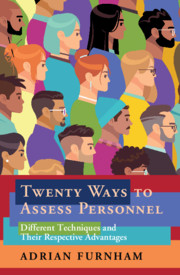Book contents
- Twenty Ways to Assess Personnel
- Twenty Ways to Assess Personnel
- Copyright page
- Dedication
- Contents
- Tables
- Preface
- Acknowledgements
- 1 Introduction to Selection and Assessment
- 2 Complex and Sticky Issues in Assessment and Selection
- 3 Traditional and Mainly Discredited Assessment Methods
- 4 Self-Report Tests
- 5 Observer Reports
- 6 Behavioural Tests
- 7 Physiology
- 8 Biography
- 9 Big Data
- 10 The Future of Assessment
- Index
- References
1 - Introduction to Selection and Assessment
Published online by Cambridge University Press: 11 June 2021
- Twenty Ways to Assess Personnel
- Twenty Ways to Assess Personnel
- Copyright page
- Dedication
- Contents
- Tables
- Preface
- Acknowledgements
- 1 Introduction to Selection and Assessment
- 2 Complex and Sticky Issues in Assessment and Selection
- 3 Traditional and Mainly Discredited Assessment Methods
- 4 Self-Report Tests
- 5 Observer Reports
- 6 Behavioural Tests
- 7 Physiology
- 8 Biography
- 9 Big Data
- 10 The Future of Assessment
- Index
- References
Summary
This chapter looks at the background to the whole issue of when, why and how people go about selecting applicants in the workplace. It is at the heart of industrial, organisational, vocational and work psychology. The chapter suggests that there are essentially five ways to assess people in the workplace: what they say about themselves; what others say about them; their behaviour on tests or in particular situations; physical and physiological evidence and their life history The chapter considers, in detail, many attempts over the years to compare and contrast different methods of assessment based on a number of criteria, particularly reliability and validity, but also cost, legal constraints and acceptability to the candidate. The chapter also looks at the research from a practitioner perspective, namely the current practice of assessment and their beliefs about various test methods. The final section looks at changes and developments in the academic and business world with respect to assessing people.
Keywords
- Type
- Chapter
- Information
- Twenty Ways to Assess PersonnelDifferent Techniques and their Respective Advantages, pp. 1 - 44Publisher: Cambridge University PressPrint publication year: 2021



